AMD A10-5800K & A8-5600K Review: Trinity on the Desktop, Part 2
by Anand Lal Shimpi on October 2, 2012 1:45 AM ESTContent Creation Performance
Adobe Photoshop CS4
To measure performance under Photoshop CS4 we turn to the Retouch Artists’ Speed Test. The test does basic photo editing; there are a couple of color space conversions, many layer creations, color curve adjustment, image and canvas size adjustment, unsharp mask, and finally a gaussian blur performed on the entire image.
The whole process is timed and thanks to the use of Intel's X25-M SSD as our test bed hard drive, performance is far more predictable than back when we used to test on mechanical disks.
Time is reported in seconds and the lower numbers mean better performance. The test is multithreaded and can hit all four cores in a quad-core machine.
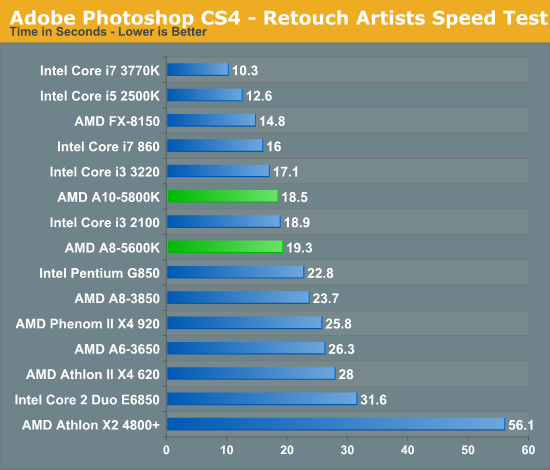
Our Photoshop workload still runs better on Intel hardware, but the gap in performance between the 5800K and 3220 is smaller than it was between the FX-8150 and 2500K last year. While Bulldozer was pretty much unrecommendable, Trinity approaches tradeoff territory.
3dsmax 9 & POV-ray
Today's desktop processors are more than fast enough to do professional level 3D rendering at home. To look at performance under 3dsmax we ran the SPECapc 3dsmax 8 benchmark (only the CPU rendering tests) under 3dsmax 9 SP1. The results reported are the rendering composite scores.
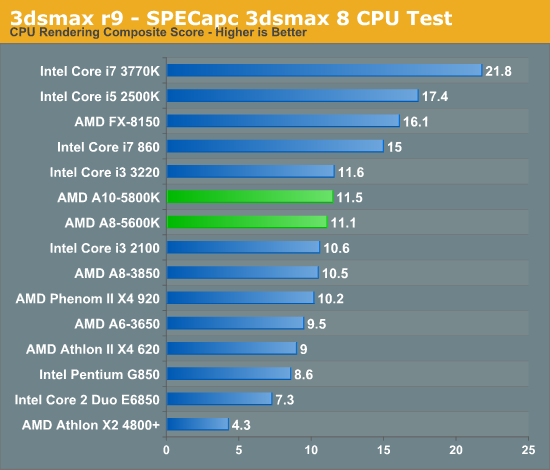
Once again in a heavily threaded FP benchmark, the A10 and Core i3 perform very similarly. POV-Ray is another example of this below:
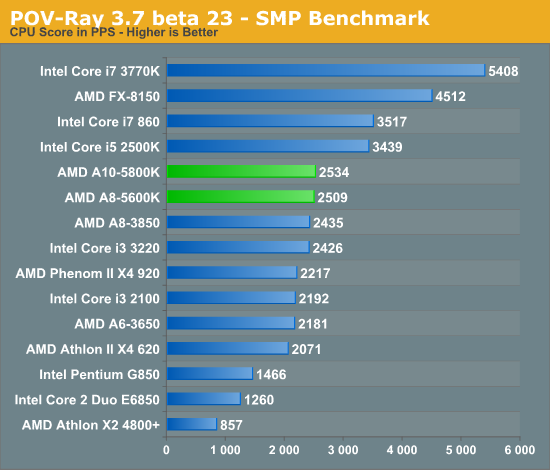
File Compression/Decompression Performance
Par2 is an application used for reconstructing downloaded archives. It can generate parity data from a given archive and later use it to recover the archive
Chuchusoft took the source code of par2cmdline 0.4 and parallelized it using Intel’s Threading Building Blocks 2.1. The result is a version of par2cmdline that can spawn multiple threads to repair par2 archives. For this test we took a 708MB archive, corrupted nearly 60MB of it, and used the multithreaded par2cmdline to recover it. The scores reported are the repair and recover time in seconds.
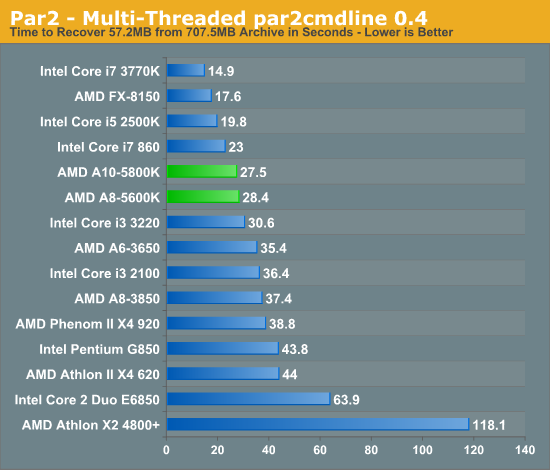
Our multithreaded Par2 recovery test shows AMD with a small advantage over the Core i3 3220, although it obviously can't touch any of the more expensive quad-core parts.
Excel Math Performance
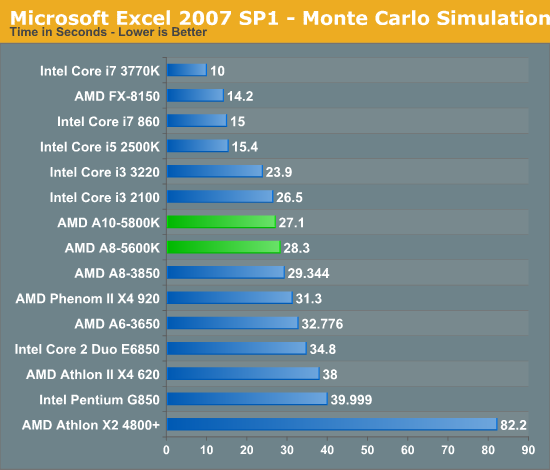
Not all heavily threaded FP applications are easy wins for AMD. In our Monte Carlo simulation benchmark the 3220 manages a decent lead over the A10-5800K.
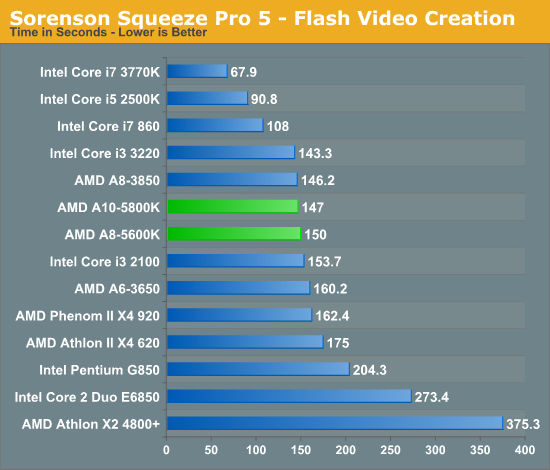
Our old Sorenson Squeeze test is one area where we see a slight regression compared to Llano. Like I mentioned earlier, this isn't super common but it does happen from time to time given the dramatic architecture difference between Llano and Trinity.










178 Comments
View All Comments
jamyryals - Tuesday, October 2, 2012 - link
On the whole, mainstream consumers do not use desktop PCs. They use laptops.Beenthere - Tuesday, October 2, 2012 - link
Sorry but your beliefs on laptop vs. desktop usage is incorrect. While a lot of young people, sales people etc. use laptops, the split is almost 50/50 according to a recent survey, meaning that ~50% of PC users still use desktops.That being said, Trinity laptop is by far the best choice for mainstream consumers who prefer a laptop over a desktop.
Either way it's a win for AMD and consumers on the desktop or for a laptop. Servers will be next as the AMD APUs have shown excellent results for servers even though they were never intended for same.
silverblue - Tuesday, October 2, 2012 - link
No, but Trinity sports a CPU architecture slanted towards servers. It's not such a strange idea in the end.BSMonitor - Tuesday, October 2, 2012 - link
Could it simply be the priorities of the target customers that so greatly affect how Intel approaches the markets and SKU's??It seems like it would be very easy to grow the die and throw 24-32 EU's on the iGPU side of things. However, what portion of their vast corporate PC market really wants or could use that?? Application developers, end users, small business PCs, etc, etc do not benefit from extra gaming performance or video/encryption performance. Seems to me the market for fast video encoding, high FPS gaming is not this market. Those people buy horsepower. And then, power usage, cost is less important.. This group buys small footprint, low power consumption, and mass quantity..
I think the times for the consumer retail PC space driving revenues are over. And Intel knows this. Retail markets are cheap, cheap laptops, tablets and smart phones..
They cannot completely ignore it, but no one in that space buys "specs". Open Best Buy ad, go buy cheapest PC/laptop/tablet, have a nice day.
AMD is not going to win over corporate markets with high power consumption, better 3D performance APU's... Just like they aren't going to win retail with more features/better specs..
mattlach - Tuesday, October 2, 2012 - link
With IGP's like this, it won't be long before Nvidia is in real trouble.Their high end parts will still sell, but their volume shipments that keep the lights on are in the budget parts, and with better and better IGP's no one is going to need them anymore.
I don't even know what kind of solution Nvidia may come up with for this. They can't design their own desktop/laptop CPU component (or at least this is highly unlikely). It also seems unlikely that they'd get bought up by Intel at this point.
So what is left for them?
Maybe a deal with Cyrix/Via/Centaur (or whatever they are called this week) or ARM or some other minor player?
Exit the desktop GPU market all together and focus on their Tegra/ARM designs?
I can think of a few ways this will go, and none of them are particularly good for the desktop video card market.
jwcalla - Tuesday, October 2, 2012 - link
Hence why they got into the mobile market. NVIDIA had the foresight to see the changes in the market and got in on the ground floor. And while Tegra isn't exactly the best SoC out there, it's won some tablet orders and NVIDIA can always improve it as they go along.At least they're in the game.
Their discrete GPUs will continue to have a presence in the HPC market, and with NVIDIA slapping an ARM co-processor on their GPUs (~2013-'14), I think they'll be even more competitive in that market in the future. And it also allows them to offer an attractive option for any potential console system down the line, or even HTPC devices.
So I think their discrete video card business has to continue to be nurtured even if they lose a bit on the desktop side.
mattlach - Tuesday, October 2, 2012 - link
I agree.I don't think Nvidia will be in trouble of going out of business, but they may be forced out of the desktop GPU market.
Currently, they are able to spread the cost of R&D on a new architecture over low, medium and high end parts. (the chips are not always the same, but the base architecture, where most of the development work goes, is)
If the low end volume parts go away, it becomes tough to see how they continue to maintain profitability on the high end GPU's.
They will always have their mobile market, and it is a good market to be in, but I'm concerned we might be left with only one player in the high end GPU market.
mattlach - Tuesday, October 2, 2012 - link
I'd be interested in building an HTPC around this platform, but I'd want a low power part.It's a little disappointing that there is no sub 65W part.
A desktop version of a mobile trinity part would be perfect for this.
cjs150 - Tuesday, October 2, 2012 - link
That was my thought as well. Intel have an i7-3770T, over priced, way over-powered for an HTPC (and yes I bought one!) but TDP of 45W.AMD need a A10 class chip with a TDP of 35W or less. The move down to 22nm fab cannot come fast enough
jwcalla - Tuesday, October 2, 2012 - link
It really depends on the intended usage of the HTPC. I'm not sure what the deal is with Hulu and Netflix (i.e., if they're CPU bound), but if your usage pattern mostly centers around hardware video decoding, then most of these chips are going to be well overdone.A simple Zotac Zbox w/ Celeron + NVIDIA ION is going to be more than enough (as long as you don't have Hi10p content), and for video decode VDPAU is far more mature than anything I've seen from Intel / AMD at this point.
And within 6 months I'd be looking into ARM-based solutions which should be even cheaper, smaller, quieter and cheaper to upgrade (e.g., when H.265 comes out). (Unless one insists on using non-ARM ported software, like maybe WMC.)